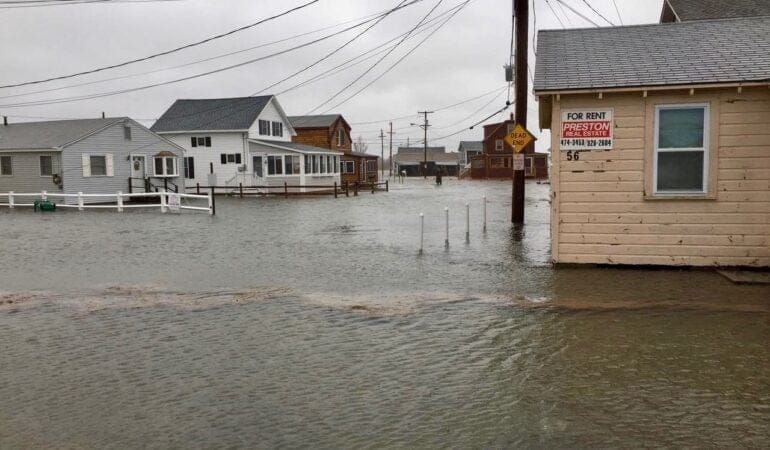Presentations, Session Video Clips, & Agenda
Friday, March 29: Forum Day One
Residence Inn by Marriott Phoenix Downtown – Encanto 1 & 2
132 South Central Avenue
Phoenix, AZ 85004
8:00 – 8:30 AM: Registration and Breakfast
8:30 – 9:00 AM: Introduction and Welcome
George W. “Mac” McCarthy, President & CEO, Lincoln Institute of Land Policy
Kathryn Lincoln, Board Chair and Chief Investment Officer, Lincoln Institute of Land Policy
Christopher Callahan, Arizona State University Dean, University Vice Provost and Arizona PBS CEO
9:00 AM: Opening Keynote
Bruce Babbitt, Former U.S. Secretary of the Interior and Governor of Arizona
9:20 – 9:35 AM: Break
9:35 – 10:50 AM: Session 1: Framing the Context/Hydrology and History of the Colorado River
We’ll start with the big questions for the Colorado River Basin: How did we get here? How has the system worked over the past 100+ years, right up to the situation we find ourselves in today? How do past decisions shape future options? This session will swiftly walk journalists through the basics, provide a refresher for veteran water beat reporters, and allow us to quickly dive into a higher–level discussion.
Moderator: Allen Best, Producer, Energy News Network
Panelists: Daniel Bunk, Deputy Chief, Boulder Canyon Operations Office, Lower Colorado Region, U.S. Bureau of Reclamation; Anne Castle, Senior Fellow, Getches-Wilkinson Center for Natural Resources, University of Colorado, Boulder; Sara Porterfield, Founder, Tributaries Consulting LLC
Session 1 Presentation – Daniel Bunk, USBR
Session 1 Presentation – Jim Holway, Babbitt Center
Session 1 Presentation – Sara Porterfield, Tributaries Consulting
10:55 AM – 12:15 PM: Session 2: Hydrology, Climate, and Tribes: How Warming Is Changing Everything
We can’t talk about water without talking about climatic variability and long–term climate change, which exacerbates scarcity in the Colorado River basin and elsewhere. We will review two major basin studies, including the recent Tribal Water Study, and consider the role of tribes and how climate change will intensify the challenges. Solutions must be seen through the climate lens, now and into the future.
Moderator: Ariana Brocious, Senior Reporter/Producer (The Buzz), Arizona Public Media
Panelists: Pamela Adams, Native American Affairs Program Manager, Lower Colorado Region, U.S. Bureau of Reclamation; Kathy Jacobs, Director, Center for Climate Adaptation Science and Solutions, University of Arizona; Daryl Vigil, Water Administrator at Jicarilla Apache Nation
Session 2 Presentation – Pam Adams, USBR
Session 2 Presentation – Kathy Jacobs, U of A
12:15 – 1:15 PM: Lunch
Residence Inn by Marriott Phoenix Downtown – Encanto Pre-Function Room
1:15 – 2:25 PM: Session 3: Around the Water Table: Connecting Stakeholders
If whiskey is for drinking and water for fighting over, it’s largely due to the emotional and cultural associations that have built up a dynamic over the years. Different groups representing agriculture, business and economic growth, the environment, urban development, just to name a few, tend to make assumptions about each other’s motives. How can traditional stakeholders and newer interests, including the business community find common ground to support difficult decisions?
Moderator: Bret Jaspers, Senior Field Correspondent, KJZZ
Panelists: Paul Bruchez, Rancher, Reeder Creek Ranch; Terry Brunner, Founder, Grow New Mexico; Kirsten James, Director of California Policy, Ceres, Inc.
2:30 – 3:40 PM: Session 4: Linking Land and Water in the Colorado Basin
In this session we’ll explore the water management frameworks in several basin states and a community’s innovative efforts to address the Colorado River Basin water sustainability through the critical interplay of land and water. Discussion will include how land use planning has a direct impact on water use, and ultimately water availability. How can these two worlds be bridged to better meet the needs of people, agriculture, and nature?
Moderator: Vanessa Ruiz, Director-Borderlands Bureau at Cronkite News, Walter Cronkite School of Journalism and Mass Communication and Arizona PBS, Arizona State University
Panelists: Andrew Fahlund, Senior Program Officer, Water Foundation; Stu Feinglas, Retired Water Resources Specialist, City of Westminster, Colorado; Jim Holway, Director, Babbitt Center for Land and Water Policy
Session 4 Presentation – Andrew Fahlund, Water Foundation
Session 4 Presentation – Stu Feinglas, Retired City of Westminster
Session 4 Presentation – Jim Holway, Babbitt Center
3:40 – 4:00 PM: Break
4:00 – 5:20 PM: Session 5: Future Water Supplies, Technology, and Conservation
We’ll examine how technological advances and cutting–edge conservation practices can help improve water sustainability. Judge whether advances in desalination, smart infrastructure, gaining efficiencies in distribution, and effluent re–use are supplementary or central steps for better water management.
Moderator: Daniel Rothberg, Reporter, The Nevada Independent
Panelists: Sean Bothwell, Executive Director, California Coastkeeper Alliance; Chuck Cullum, Colorado River Program Manager, Central Arizona Project; Sara Ransom, Deputy Civil County Attorney, Cochise County Attorney’s Office
6:30 – 9:00 PM: Babbitt Center For Land and Water Policy Reception & Dinner
Special Guest Appearance: Not So Stranger than Fiction: A Conversation with Paolo Bacigalupi, author of the Water Knife
Residence Inn by Marriott Phoenix Downtown – Encanto Pre-Function Room (reception), Encanto 1 & 2 (dinner)
132 South Central Avenue
Phoenix, AZ 85004
Saturday, March 30: Forum Day 2
Residence Inn by Marriott Phoenix Downtown – Encanto 1 & 2
132 South Central Avenue
Phoenix, AZ 85004
7:30 – 8:30 AM: Breakfast
8:30 – 8:40 AM: Day 2 Opening Comments
8:40 – 9:55 AM: Session 6: Innovations in Water Data and Decision Support Tools
Huge advances in satellite data collection, mapping, improving data access, scenario planning, and simulation exercises can help stakeholders understand actual conditions and constraints to guide policies based on solid evidence. These tools are critical because of the element of uncertainty in our water future. What twists and turns do the data suggest might be in store?
Moderator: Mitch Tobin, Director, The Water Desk, University of Colorado
Panelists: Jeffrey Allenby, Director of Conservation Technology, Chesapeake Conservancy; George McCarthy, President and CEO, Lincoln Institute of Land Policy; Jessica Norriss, Policy & Partnerships, Upstream Tech
Session 6 Presentation – Jeff Allenby, CIC
Session 6 Presentation – Jessie Norriss, Upstream Tech
10:00 – 11:45 AM: Session 7: Preparing for Potential Shortages: Colorado River Drought Contingency Planning
The way the Colorado River Basin confronts a near–term challenge – potential shortages as early as 2020 – might provide a roadmap for addressing scarcity longer–term. We will discuss system conservation, Upper vs. Lower basin perspectives, and powerful underlying issues of equity. Can this work become a blueprint for the future?
Moderator: Ian James, Reporter, The Arizona Republic
Panelists: Sandy Bahr, Grand Canyon Chapter Director, Sierra Club; Clint Chandler, Assistant Director, Arizona Department of Water Resources; Lorelei Cloud, Treasurer, Tribal Council, Southern Ute Indian Tribe; Michael Cohen, Senior Associate, Pacific Institute; Jim Lochhead, CEO/Manager, Denver Water; Leslie Meyers, Area Manager, Phoenix Area Office, U.S. Bureau of Reclamation; Kevin Moran, Senior Director, Ecosystems Water Program, Environmental Defense Fund; Commissioner Roberto Salmón, Mexican Commissioner, Mexico-United States International Boundary and Water Commission
11:50 AM – 1:00 PM: Working Lunch Keynote Addresses on Federal and Tribal Perspectives
Terry Fulp, Lower Colorado Regional Director, U.S. Bureau of Reclamation
Roberto Salmón, Mexican Commissioner, Mexico-United States International Boundary and Water Commission
Governor Stephen R. Lewis, Gila River Indian Community
Residence Inn by Marriott Phoenix Downtown – Encanto Pre-Function Room
1:05 – 2:20 PM: Session 8: Toward Sustainable Futures for the Colorado River
Further discussions with consideration of what’s next – exploring longer term and more significant changes that delve into the concept of water markets, new ideas about system conservation and governance, and water transfers to support growth. What would it take to bring the basin into balance?
Moderator: Matt Jenkins, Freelance Journalist
Panelists: Anne Castle, Senior Fellow, Getches-Wilkinson Center for Natural Resources, University of Colorado, Boulder; Pat Mulroy, Senior Fellow, William S Boyd School of Law, University of Nevada, Las Vegas; Jennifer Pitt, Colorado River Program Director, Audubon; Dave White, Director, Decision Center for a Desert City, Arizona State University
2:25 – 3:45 PM: Session 9: Practicing the Craft: Covering Water and Public Awareness about Water and Land Connections
The Forum’s closing session will be enlightening and aspirational. The moderator and panelists reflect on their experiences and suggest insights gleaned from the previous sessions, prompting a conversation driven by the attending journalists. What are the challenges of covering the water beat, especially in an environment of turbulence and dwindling resources in journalism? What topics do journalists find get most attention from readers and editors? What are they incentivized to write and what does not get covered? The discussion will lead where it may – but will segue to the conclusion and major messages from the Forum.
Moderator: Mi-Ai Parrish, Sue Clark-Johnson Professor in Media Innovation and Leadership, Arizona State University
Panelists: Elizabeth Hightower Allen, Features Editor, Outside Magazine; Cynthia Barnett, Environmental Journalist in Residence, University of Florida College of Journalism and Communications; Sinjin Eberle, Communications & Visual Media Director, American Rivers
3:45 – 4:00 PM: Closing Remarks
























































